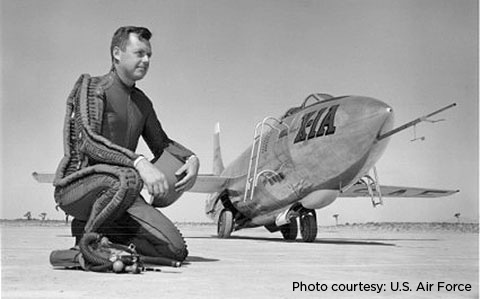
Arthur “Kit” Murray, the test pilot who in 1954 became the first pilot to fly above 90,000 feet, and see earth's curvature in flight in a Bell X1-A, died July 25 in Texas. He was 92.
Murray's altitude record led to his becoming known at the time as America's first space pilot. His fellow test pilot and colleague Chuck Yeager had broken the sound barrier for the first time in an X-1 in 1947. Murray's death was noted in major newspapers with obituaries that chronicled his pioneer's role in jet aviation and the early space program.
Murray was born Dec. 26, 1918, in Cresson, Pa. He enlisted in the army in 1939 and served in the cavalry, volunteering for pilot training after the Dec. 7, 1941, attack on Pearl Harbor. He flew combat missions in Africa in P-40s, later returning stateside and becoming an instructor in the P-47. An assignment as a maintenance test flight pilot led to his becoming the first pilot to be based for test flights at Muroc Airfield, which would later be named Edwards Air Force Base in California. There he flew some of the earliest jet aircraft, as well as the Bell X-1A, X1-B, the flying-wing-design X-4, and the X-5, according to published biographies. A New York Times obituary of Murray gave his description of one of two supersonic spin recoveries he was forced to make when test flying the X-1A at high altitudes.
His six-year stint as a test pilot was followed by assignments in Europe, and at Wright-Patterson Air Force Base, where he would manage the X-15 program.
In 1960 Murray retired, having earned the Distinguished Flying Cross and Air Medal with eight oak leaf clusters. He went to work on space program projects for Boeing, including the Apollo program, moving to the Fort Worth, Texas, area in 1969 to work on Bell Helicopter's tilt rotor aircraft program.
After a second retirement he continued flying as an occasional charter pilot, and also reported court news for a newspaper in Bosque County, rode horses, and managed a hunting club, according to biographical information posted on the web site of a funeral home in the town of West, Texas.
Murray's passing was especially noted by Experimental Aircraft Association Chapter 59 in Waco, Texas, of which he was a member. An online member profile of Murray written by chapter member Mike McMains appears on the Chapter 59 website.
Another chapter member, retired fighter pilot Emmette Craver, recalled an enthralling school appearance Murray made in McGregor in 2003 before an audience of students and staff.
“The school went to a lot of work to make the day a great one for Kit,” Craver said. “They had one of the photos of him in his space suit in front of one of the planes blown up to about a 30-by-40-inch size and hung on the wall.”
Murray autographed the photo. Some of the pupils “would not leave and go back to class because they wanted to talk to him more than the allotted time they were given.”
Murray had the right stuff for making a perfect presentation before teacher Jennifer Millsap's class. Craver recalled: “His presentation to us would have been suitable for a theater with thousands of dignitaries in the audience. He did not talk down to the students and did not in any way try to glorify his accomplishments. He just put on a very informative and complete discussion of the program and his part he played.”
“He was a great gentleman,” Craver said.
McMains said that he was honored to lead a missing man formation flown over a memorial service for Murray at a family member’s request. “He is certainly past due for recognition of his aviation accomplishments,” McMains said in an email message.
Murray is survived by his wife, Ann, five sons, a daughter, three stepdaughters, 16 grandchildren, 13 great grandchildren, three step grandchildren and a step great grandchild.



